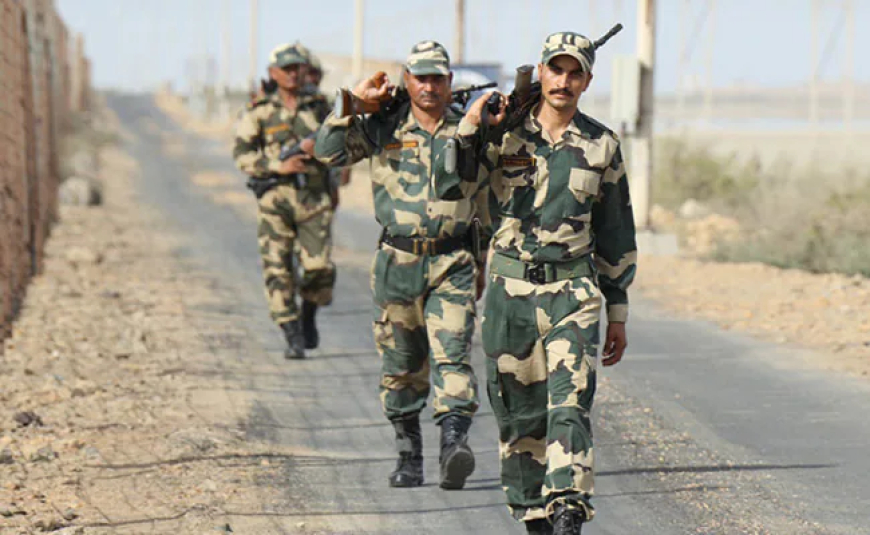BSF Thwarts Major Gold Smuggling Bid Near Bangladesh Border: 2.45 Kg Seized Worth ₹2.43 Crore
BSF intercepts 2.451 kg of gold near the India-Bangladesh border in North 24 Parganas. Seizure worth ₹2.43 crore highlights rising gold smuggling threat in West Bengal.

Kolkata, June 26, 2025 — In a decisive operation, the Border Security Force (BSF) on Wednesday foiled yet another high-value gold smuggling attempt along the India-Bangladesh border, seizing 2.451 kilograms of gold estimated to be worth over ₹2.43 crore. The interception, carried out in North 24 Parganas district of West Bengal, underscores the continued vulnerability of India’s eastern frontier to cross-border gold trafficking.
This latest bust comes amid heightened vigilance and increased smuggling attempts via land and riverine routes, particularly across porous sections of the Indo-Bangladesh border in West Bengal.
How the Operation Unfolded
According to a statement released by the South Bengal Frontier HQ of BSF, the gold seizure occurred near Border Outpost (BOP) Hakimpur, under the jurisdiction of the 112 Battalion.
“Acting on intelligence inputs and routine surveillance, BSF troops noticed suspicious movement along the border fence just before dawn. Upon interception, the smugglers fled towards Bangladesh, leaving behind a consignment wrapped in cloth near the barbed-wire fencing,” the statement said.
The package contained six gold bars, weighing a total of 2.451 kg, neatly wrapped in polythene. No arrests were made at the scene, but search operations are underway in nearby border villages.
Cross-Border Smuggling Patterns on the Rise
Officials confirm that this is part of a wider smuggling nexus operating through Bangladesh’s Satkhira and Khulna divisions, using Indian villages like Bagdah, Gojadanga, Petrapole, and Swarupnagar as entry and exit points. These areas, known for their riverine terrain and gaps in fencing, offer smugglers both cover and mobility.
According to the Directorate of Revenue Intelligence (DRI), gold smuggling through Bangladesh has doubled over the past two years, with India witnessing a surge in non-banked, undocumented gold inflow to avoid 15% import duties.
A detailed 2024 report by the Observer Research Foundation warned of increasing sophistication in smuggling networks involving mobile app coordination, use of drones, and local handlers posing as fishermen or agricultural workers.
Financial Impact and Legal Action
The market value of the seized gold is estimated at ₹2.43 crore based on current rates issued by the India Bullion and Jewellers Association (IBJA). The seized metal was handed over to the Customs Department in Bangaon for further investigation under provisions of the Customs Act, 1962.
If caught, smugglers may face imprisonment up to 7 years along with monetary penalties. In many recent cases, gold has also been concealed inside body cavities, electronic items, and even gas cylinders, according to customs officers at Petrapole Land Port.
BSF’s Vigilance and Border Challenges
BSF authorities report that this was the 12th gold-related seizure in South Bengal this year alone, with a total haul of over 18 kg of gold so far in 2025. The force has intensified its use of thermal imaging, night vision cameras, and mobile surveillance units to curb illicit border activity.
“The border’s geography, marked by paddy fields, narrow river channels, and interlinked households, makes monitoring extremely challenging. Yet, our troopers have maintained high alert,” said DIG S.S. Guleria, South Bengal Frontier.
For additional context, BSF’s official website provides regular updates on smuggling interdictions and enforcement measures.
Geopolitical Dimensions and Regional Risk
India and Bangladesh share a 4,096-km border, one of the world’s longest, with 2,217 km in West Bengal alone. Smuggling along this stretch includes not only gold but also cattle, narcotics, and human trafficking.
While bilateral cooperation has improved — with regular DG-level talks between BSF and Border Guard Bangladesh (BGB) — gaps in enforcement persist due to local complicity, porous terrain, and weak prosecution.
Security analysts argue that smugglers often reinvest profits in trafficking other contraband, making gold smuggling a gateway crime that funds wider illegal trade.
A comprehensive study on these cross-border dynamics is available through the United Nations Office on Drugs and Crime (UNODC).
Citizens Urged to Report Suspicious Activity
In response to rising smuggling attempts, BSF has encouraged local residents to report suspicious activity through its Seema Saathi Helpline (14419). Those providing credible information leading to seizures are eligible for government rewards, and their identities are kept confidential.
Local NGOs such as Prayas and Banglar Manabadhikar Suraksha Mancha (MASUM) have also launched campaigns to spread awareness about how smuggling impacts rural stability and national security.
Conclusion: Seizure Reinforces Security Gaps
This latest interception by the BSF is a reminder of the persistent security vulnerabilities along India’s eastern border. With gold prices soaring and demand surging in unorganized markets, smuggling remains a lucrative criminal enterprise.
As central authorities push for better fencing, community intelligence, and joint enforcement, the need for technological innovation and regional cooperation with Bangladesh will be critical to ensure that India’s borders remain secure and its economy protected from illicit gold flows.














